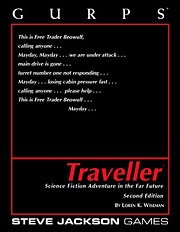Twilight and the Long Night
Historians generally acknowledge the beginning of the Twilight of the Second Imperium as starting with the monetary crisis of -1776 Imperial. When the Imperial Treasury on Hub refused to acknowledge the monetary issue made by the branch treasury at Antares, shockwaves of fiscal doubt spread throughout the empire. As with all large interstellar polities, the lifeblood of the Second Imperium was interstellar trade, and once it became unclear that the currency issued by one part of the Imperium would be recognized in another, commerce began its inexorable grind to a halt.
Though the damage began almost immediately, the Second Imperium was a vast and resilient polity, and took two and a half centuries to completely collapse - its death throes are generally recognized as ending in -1526 Imperial when the last remnant state claiming to be the Rule of Man splintered and broke apart. This period of Twilight was followed by a fifteen hundred year period of chaos commonly referred to as the Long Night, which only ended when Cleon transformed the Sylean Federation into the Third Imperium and declared himself Emperor in the year 0.
During the Long Night, interstellar trade was reduced to trickle in most regions of the former empire. Remnant states arose in some places, while in other regions some systems were cut off from galactic society by stellar geography or mere neglect. Many planets, lacking regular shipments of Imperial products, regressed technologically, descending into pre-industrial societies. Others, deprived of essential commodities and unable to meet their needs with domestic production, simply died off. Where interstellar travel was still possible, successor states that came into contact with one another began warring as often as they began trading. Miniature empires rose, prospered, and fell throughout the Long Night, and in many cases, surviving records are fragmentary or entirely missing. One of the great endeavors of academia in the Third Imperium is unearthing and understanding information about this period.
Despite the chaos and uncertainty of the Long Night, it was also a period of growth and expansion for humanity. Unfettered by the cumbersome bureaucracy of the First Imperium and the military rule of the Second Imperium, humanity expanded far beyond its former borders. Solomani made contact with the Darrian strain of humaniti - and after receiving the jump drive from Solomani traders, the Darrians achieved (and lost) technological capabilities as yet unmatched in human history, including the infamous Star Trigger. Humaniti made contact with the K'kree, and established stronger relations with the Aslan. In addition, while the areas formerly occupied by the Imperium had descended into chaos, other regions of the galaxy had not. The Zhodani Consulate never experienced the Long Night and grew to its present size during that era. The Vargr and Aslan experienced some of the greatest surges of expansion in the racial histories. In the case of the Aslan, their push into human held regions of space resulted in the first in a series of border wars that spanned nearly fourteen hundred years and didn't end until the nascent Third Imperium finally organized resistance to the incursions.
The ending of the Long Night was set into motion with the founding of the Sylean Federation, an interstellar state founded in the Sylea system in what is now the Core Sector in -650 Imperial. The Federation had a tightly controlled, highly centralized government, and thus it too nearly six centuries to grow, mostly by using its dominant trading position to draw several surrounding systems into itself. The typical Sylean method of expansion was to establish a trading relationship with another system, arrange for their trading partner to become dependent upon Sylean goods, and then use that dominant position to force the system to agree to join the Federation. In -30 Imperial, Cleon Zhunastu took control of the industrial consortium that was the real power in the Federation and set about expanding its borders. Over thirty years of flexing Sylea's economic, diplomatic, and military might, Cleon had vastly increased the size of the Federation, extending it to encompass nearly all of what is now the Core Sector.
Cleon envisioned a dominion that extended well beyond a single sector, and realized that the heavily centralized Sylean government was not suited to such a task. Through intense political maneuvering, Cleon's allies convinced the Grand Senate of the Federation to propose that the Imperium be revived and that Cleon should be crowned the first Emperor of the Third Imperium. This claim was made plausible due to the fact that one of the last claimants to the throne of the Rule of Man during the Twilight years had used Sylea as his capital. Thus, Cleon was able to trace the legitimacy of the Sylean Federation itself through this petty emperor to the Rule of Man, and consequently to the original Vilani Empire. In a somewhat perverse way, the primary proponents of the legitimacy of the Ramshackle Empire as the legitimate heir to the First Imperium are the Emperors of the Third Imperium, as their claim to rulership is based upon that connection.
Given that Cleon had instigated the political maneuvering that led to him being offered the crown, Cleon, of course, accepted immediately. 651 years after the Sylean Federation had been founded, it was dissolved. Cleon declared that the year of his ascension to the Imperial Throne to be a Holiday Year to mark his coronation, proclaiming it to be Year Zero of a new calendar. Though most of the galaxy didn't know it yet, the Long Night had ended, and the Third Imperium had begun.
Third Imperium Home

No comments:
Post a Comment